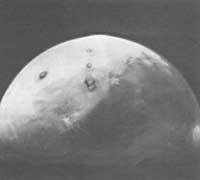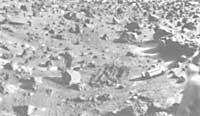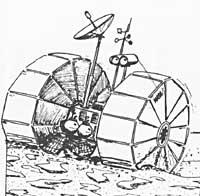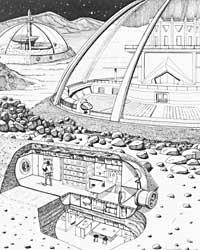Martitz, is it the second house of humanity?
1986/04/01 Barandiaran, Mariaje | Irazabalbeitia, Inaki - kimikaria eta zientzia-dibulgatzaileaElhuyar Fundazioa Iturria: Elhuyar aldizkaria

Some astronomers need thirty million years to colonize the entire galaxy. Exporting our civilization to 200 billion stars is not a joke problem. We will not know. However, in the coming years we will probably see the first steps of this colonization.
The beginning of colonization can occur at the beginning of the next century. Technology will then establish sustainable bases on the Moon and Mars.
The first bases will be built on the Moon. There are many reasons for this to happen, including closeness. The following will be placed on Martitz, as on the two closest planets is the most suitable and with the softest "climate". Articulating for the moment is more inaccessible. Its enormous pressures and temperatures make living in the area not advisable.
Although no man has yet been released, the placed automatic probes have provided us with significant data. The princesses described by Edger Rice Borroughs have not been found. Neither the builder of "channels" of Schiaparrelli. also. But it offers scientists a useful starting point to work on the colonization of Mars.

Leaving the first level of the Moon, we begin the second of Mars.
For the life we know Martin is not a very attractive planet. Temperatures range from -140° C to -27° C. The average temperature around the poles is -100 °C, at the equator -20 °C and at the mean latitudes of -40 °C. On the other hand, the atmosphere is completely made up of carbon dioxide. The pavement is also sterile.
So we can transform it to our needs. Only imagination and technique are needed. This totally poisonous atmosphere also has a possible use. Thomas Meyer, a chemist working on the Martitz project at the University of Colorado, analyzes the data emitted by the Viking probes, obtaining interesting conclusions.
According to this researcher, the compression of 900 m 3 of martyr air allows obtaining 500 g of water. Thus, the cost of "distilled" water would not be higher than that of mineral water you can buy at the corner store.

No complex appliances are needed, just a turbine that speaks of solar energy that can work at low pressure.
If we have something to drink, we will have to find food and what is more important, and what to breathe. It can also be found. By compressing the atmosphere and removing carbon dioxide, a mixture of gases is obtained. In it argon and nitrogen predominate, with oxygen as a trace.
This mixture is not very breathable, but could be used as "Tampon" gas, between the breathable air of the habitats and the toxic air outside. Respiratory oxygen would be obtained by breaking carbon oxide (IV) through the process called Sabatier-Senders. It generates carbon dioxide and water. Oxygen is extracted from electrolysis water, regenerating hydrogen. Recycling this hydrogen...
The atmosphere of Martitz could bring even more fruits with nitrogen and hydrogen, ammonia, CNH 3 could be synthesized. It could be used to power plants or electrolyte batteries. Taking ammonia as a raw material, it could produce hydrazine (NH 2 NH 2), ideal fuel for rockets. Using Martian chemicals, water, hydrogen and carbon oxide (II) could also synthesize methanol, fuel for land vehicles...

Project Director Martitz, Penelope Boston, prefers water to leave the ground on the red planet. It also uses Viking probe data. The powder that covers Martitz could reach 1 Kg of water, eliminating 100 Kg.
Mrs. Boston sees three stages in the colonization of Mars. In a first step the colonies of algae and bacteria would be exported with the intention of sowing on the planet. If these were not rooted, they would be the food of the first settlers.
In the next step some inflatable "domes" would swell. There, settlers who would be fed up with algae and bacteria could grow vegetables, taking as a substrate the moist soil of Mars. The third step would be to complete a very miniaturized ecosystem.
The only work of the settlers of Martitz would not be agriculture. Once primary needs are met, they should start exploiting the areas. The first work would be mining, followed by the construction of small processing industries and finally the creation of a bad copy of the land.

This is a scheme of colonization of Mars. Among them are others, Among them the most outstanding may be that of James Lovelock, atmospheric chemical. James Lovelock is well known for the alleged hypothesis he raises about life on Earth in the book "GAIA"
Lovelock proposes to plant life on Mars with simple tricks. It intends to use in its project elements harmful to the earth: rockets carrying nuclear heads and chlorofluoromethanes. It is suspected that the latter can destroy in the form of aerosols the ozone layer that protects on our planet from ultraviolet radiation.
After the disarmament agreements, the rockets would be placed in the hands of the Martitz project (undoubtedly the weakest point of this intention). These gases would project to Mars and disperse into its atmosphere. It would produce the greenhouse effect, that is, the heat of the sun would enter the atmosphere but would not come out. The warming of Martitz would be as follows: the poles of ice and solid carbon oxide (IV) would melt and become steam. In this way, the excess carbon oxide (IV) would further raise the temperature and at the same time the atmosphere would humidify.

Other rockets sent from the ground, in this new atmosphere, would remove spores of mature lichens and algae. These spores would reproduce quickly. These pioneers would prepare the earth chemically. The following shipments from the ground would be composed of superior plants, grasses and shrubs. Since the atmosphere is very rich in carbon oxides (IV), huge amounts of oxygen would occur.
If this plan were successful, in a few decades 10,000 people could live on Mars...
As dreaming for the moment is legitimate, (and we hope it will always be) dreamers may prefer stars, exotic landscapes of Borrough than hard areas of reality.
When I opened my eyes, I saw that I was surrounded by a strange and unnatural landscape. I knew I was on Mars. I did not wonder if I was awake and attentive. I wasn't asleep, I didn't have to bother. My subscientist told me he was on Mars, as he says to anyone else on Earth. No one doubts it...
... that soft sound made me spin and there just three meters from the chest was the tip of that colossal. A tuft twelve meters long, with shiny metal tips and held by another great being like those devils who were watching.

Man, I have to name it in some way, it was five meters long and on Earth it would weigh more than two hundred kilos. We were placed as we stood on our horses. The neck of the animal was accompanied by its lower quinces. Meanwhile, with the hands of his two arms on the right he held the colossus beside his horse. He opened his two arms on his left to maintain balance. The animal he was driving had no brakes, flanges or driving systems...(*)

Gai honi buruzko eduki gehiago
Elhuyarrek garatutako teknologia




